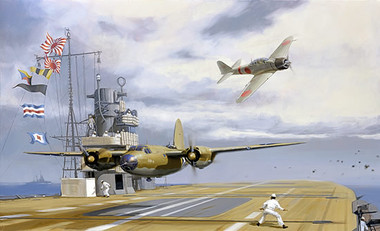 Loading... Please wait...
Loading... Please wait...- Home
- Original Paintings & Drawings
- Jack Fellows
- An Omen - Original Oil Painting
Categories
An Omen - Original Oil Painting
Product Description
Artist: Jack Fellows
Original: Height: 24" Width: 36"
Oil Painting on stretched canvas
Contact us for Shipping Prices and Details
Prints Available
Layaway Available
As it is within the Japanese character to pay attention to the symbolism that is woven by happenstance into the events of each day, the sudden early morning appearance of a Martin Marauder hurtling at prop tip height down the flight deck of the AKAGI may have seemed to Vice Admiral Chuichi Nagumo that this unlikely intruder's act was an omen of some significance. For the six months since the surprise attack on the United States' Pacific Fleet at Pearl Harbor, the Imperial Japanese Navy had rampaged, nearly unmolested, across the vast expanse of the Pacific Ocean all the way to the Indian Ocean, and South China Sea, unopposed, except, briefly at the Coral Sea. By the end of this day, the 4th of June, 1942, the fortunes of the Imperial Japanese Navy will have taken a dramatic reversal, placing them on the defensive for the rest of the war. Aboard Akagi, the flagship of the Imperial Japanese Navy's huge Midway strike force, the vaunted Kido Butai, Nagumo must have felt considerable confidence in his fleet's capacity to capture Midway, and in the process smash the remnants of the US Navy's Pacific Fleet and most particularly the carriers that the Kido Butai had missed at Pearl Harbor six months earlier, on the 7th of December, 1941. Chuichi Nagumo knew as well as anyone that the sheer size and intricate complexity of the Midway Operation increased the likelihood of the unexpected, and that no one, including the architect of this and the Hawaii Operation, Admiral Isoroku Yamamoto, possessed the prescience to divine the outcome of such an enormous undertaking. And so it would be that Chuichi Nagumo would be likely paying attention to the symbolism served up by that morning's events. On Midway, a coral atoll, consisting of several tiny islands , a patchwork defense of Marine Corps, Navy and Army attack, bomber, and patrol aircraft waited for the arrival of the huge Japanese invasion fleet that US Naval code breakers discovered to be on their way. Among this eclectic mix were four B-26 Martin "Marauder" fast medium bombers, now equipped to carry aerial torpedoes, two from the 38th Bomb Group and two from the 22nd Bomb Group, both from the fledgling 5th USAAF. Although the island was to endure a terrific pounding by the attack bombers of the Kido Butai's four fleet carriers Nagumo's strike force the Midway-based defenders put up a desperate but spirited attack on these carriers setting into motion a series of circumstances based on Admiral Nagumo's misreading the Midway-based attackers' numbers and capabilities. His decision to re-arm his four carriers' attack aircraft with ordinance intended to destroy land targets was based on the notion that his carriers were still threatened by Midway's aircraft when, in fact, except for some Army B-17s , effectively, Midway's aerial defenders were all but wiped out in the first round. The self-confident Japanese Naval planners could not have imagined that the US Naval Intelligence unit was busily reading their most secret naval communications and that the Americans had laid an ambush at Midway as a result of this compromise. Even so the Japanese were superior in the number of ships, most notably the number of aircraft carriers, and just as important, the combat-readiness of the carrier aircrews. Furthermore, at the time Midway Atollthat Lt. James Muri was hurtling down the flight deck of Akagi, mere feet away from Nagumo, in a desperate attempt to gain some respite from the attentions of Akagi's CAP Zeroes, Kido Butai reconnaissance aircraft had yet to sight any of the US Fleet, but would shortly do so. The shocking discovery of the three US carriers would then give Chuichi Nagumo the reason to once again unload the land attack ordinance that was now aboard the waiting armada of aircraft littering the flight decks of Akagi, Hiryu, Soryu, and Kaga, and proceed to reload them with ordinance more suitable for attacking ships. This fateful decision was responsible, more than anything else, for the US Navy's stunning defeat of the Imperial Japanese Naval forces during the Battle of Midway, for the Americans had already launched their attack aircraft. Had not the Midway-based attack been so spirited, and had not Lt. Muri so audaciously buzzed the Admiral, the decision to re-arm the Japanese attack aircraft for another trip to Midway, may well not have been made, and the critical launch timing between the opposing fleets would have been sufficiently altered to have created a vastly different outcome. By the end of the day, all four of the Japanese carriers had been destroyed, the USS Yorktown was the only carrier loss suffered by the United States Navy. PLANE JUNKIE - "An Omen" Original Painting by Jack Fellows








